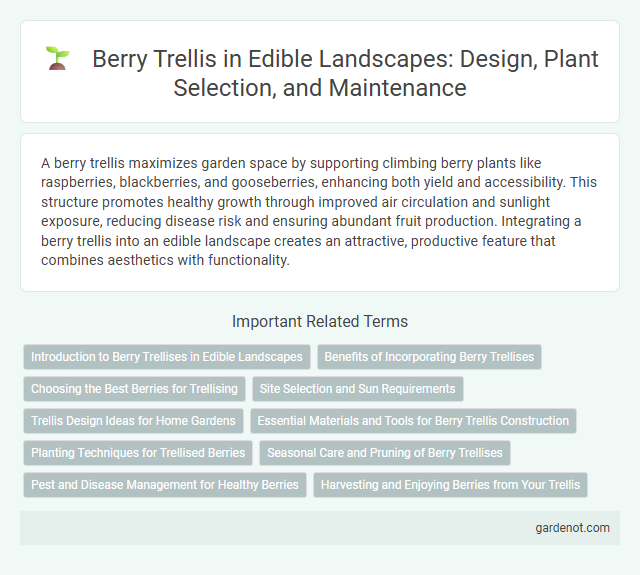A berry trellis maximizes garden space by supporting climbing berry plants like raspberries, blackberries, and gooseberries, enhancing both yield and accessibility. This structure promotes healthy growth through improved air circulation and sunlight exposure, reducing disease risk and ensuring abundant fruit production. Integrating a berry trellis into an edible landscape creates an attractive, productive feature that combines aesthetics with functionality.
Introduction to Berry Trellises in Edible Landscapes
Berry trellises enhance edible landscapes by supporting the growth of various berry plants such as raspberries, blackberries, and grapes. These structures optimize space, improve air circulation, and increase sunlight exposure, leading to higher yields and healthier plants. Integrating berry trellises creates an attractive, productive garden element that combines aesthetics with functionality.
Benefits of Incorporating Berry Trellises
Berry trellises maximize space efficiency by allowing vertical growth, increasing fruit yield per square foot in edible landscapes. They improve air circulation around plants, reducing fungal diseases and enhancing berry quality. Berry trellises also facilitate easier harvesting and maintenance, promoting healthier, more productive berry plants.
Choosing the Best Berries for Trellising
Selecting the best berries for trellising involves prioritizing varieties that naturally grow in a vining or trailing habit, such as raspberries, blackberries, and currants, which respond well to vertical support. Consider disease-resistant cultivars like 'Heritage' raspberry or 'Triple Crown' blackberry to minimize maintenance while maximizing yield. Optimal berry choices balance flavor, hardiness, and growth characteristics to enhance both the aesthetic and productivity of an edible landscape.
Site Selection and Sun Requirements
Berry trellises thrive best in well-drained soil with full sun exposure, receiving at least 6 to 8 hours of direct sunlight daily for optimal fruit production. Choosing a site with good air circulation helps prevent fungal diseases and promotes healthy growth. Avoid low-lying areas prone to frost pockets, as berry plants require consistent warmth for maximum yield.
Trellis Design Ideas for Home Gardens
Berry trellis design ideas for home gardens emphasize vertical growth to maximize space and improve air circulation, reducing disease risk. Materials like cedar or metal offer durability and weather resistance while supporting heavy berry vines such as raspberries, blueberries, and blackberries. Incorporating adjustable or modular trellis systems allows gardeners to customize support structures based on plant growth stages and garden layout.
Essential Materials and Tools for Berry Trellis Construction
Constructing a berry trellis requires essential materials such as treated lumber or galvanized steel posts, sturdy wire mesh or galvanized wire for support, and corrosion-resistant fasteners like stainless steel screws or galvanized staples. Key tools include a post hole digger for setting posts securely, wire cutters for trimming and adjusting wire lengths, and a level to ensure structural alignment. Durable materials and precise tools ensure the trellis withstands weather conditions and supports healthy berry plant growth.
Planting Techniques for Trellised Berries
Planting techniques for trellised berries include selecting disease-resistant varieties and spacing plants 18 to 24 inches apart to ensure adequate airflow and sunlight exposure. Installing a durable trellis system with horizontal wires spaced 12 to 18 inches apart supports healthy vine growth and simplifies harvesting. Regular pruning and training of berry canes along the trellis maximizes fruit production and prevents overcrowding.
Seasonal Care and Pruning of Berry Trellises
Seasonal care of berry trellises involves regular inspection for damaged or diseased canes, with pruning conducted during dormancy in late winter to early spring to promote healthy growth and maximize fruit production. Cut back old, weak, or overcrowded canes to improve air circulation and sunlight penetration, which reduces the risk of fungal diseases. Proper pruning techniques tailored to specific berry types, such as raspberries or blackberries, enhance yield and maintain the structural integrity of the trellis system.
Pest and Disease Management for Healthy Berries
Berry trellises require vigilant pest and disease management to ensure healthy fruit production, targeting common threats such as aphids, spider mites, and fungal infections like powdery mildew and botrytis. Implementing integrated pest management (IPM) techniques including regular monitoring, biological controls, and fungicide applications promotes sustainable protection. Proper pruning and optimal airflow within the trellis system reduce humidity and disease incidence, enhancing berry yield and quality.
Harvesting and Enjoying Berries from Your Trellis
Harvest ripe berries from your trellis by gently picking them when they are fully colored and easily detach from the stem, ensuring peak flavor and freshness. Regular harvesting encourages continued fruit production throughout the growing season, maximizing your yield. Enjoy fresh berries directly from the trellis or incorporate them into desserts, smoothies, and salads for a nutritious boost.
Berry trellis Infographic

 gardenot.com
gardenot.com